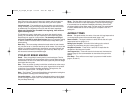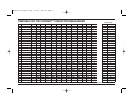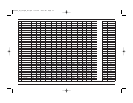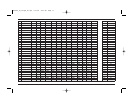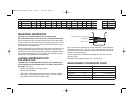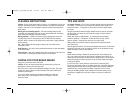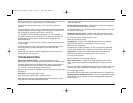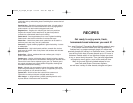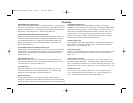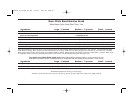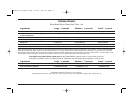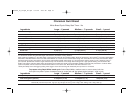
smaller amounts of flour for each size, and with Mix-ins, they may weigh more
than 1 pound (454 g), 1
1
⁄2 pounds (680 g) or 2 pounds (908 g).
You should not use more than 5 cups (1.25 L) flour total in the bread
machine.
If you are adapting a recipe, and your mathematical measurements become
something odd such as half of an egg, use a small egg as a replacement for
half. A large egg is generally equal to about
1
⁄4 cup (50 ml).
It is important to measure ingredients accurately – do not be tempted to
omit small amounts such as
1
⁄8 teaspoon (0.5 ml). Baking is chemistry, and
changing the formula by even this small amount can change the final
product significantly.
A pinch of ginger or a bit of vitamin C can give a boost to the yeast and help
it to grow better.
Too much cinnamon or garlic can counteract the rising properties of yeast.
Also in this category of “yeast destroyers” are too much citrus zest
and alcohol.
Always add nuts at the Mix-in signal. Adding them too early may result in
their becoming too finely ground.
TROUBLESHOOTING
Dough Does Not Rise Properly – Check expiration date of yeast.
Make certain yeast is fresh and properly stored (sealed, in a cool dark place).
Liquid may have been too hot and killed yeast or liquid may have been too
cool and yeast did not activate completely – liquids should be between
75 – 90°F (24 – 32°C) for best bread machine results.
Delay Start feature used, but ingredients were in bread pan in improper order.
See page 13.
Short loaves – Not enough sugar in recipe.
Not enough yeast. Yeast was old or improperly stored.
Delay Start feature used and ingredients not placed in bread pan properly.
Salt came into contact with yeast and killed yeast.
Loaves with whole wheat and/or whole grain flours will not be as tall as those
made with bread flour.
Sunken, uneven tops of loaves – High humidity or high room temperature.
Do not place bread machine in sunny window.
On high humidity days, try increasing the flour by one tablespoon (15 ml) per
cup (250 ml) of flour used.
Underbaked, gummy texture – Dough too wet. When baking next loaf of
same bread, watch dough and add flour 1–2 teaspoons (5–10 ml) at a time.
Too much whole grain or whole grain flour used.
Bread pan too small for recipe.
Collapsed loaf – Dough too wet. When baking next loaf of same bread,
watch dough and add flour 1–2 teaspoons (5–10 ml) at a time.
Water not proper temperature.
Ingredients not in proper proportions – be sure to measure dry ingredients
correctly by stirring flours first, spooning into measuring cup, then leveling.
Open texture – Dough too wet. When baking next loaf of same bread,
watch dough and add flour 1–2 teaspoons (5–10 ml) at a time.
Too much yeast was used.
Salt was omitted or incorrectly under measured.
Dense, heavy texture – Dough too dry. When baking next loaf of same
bread, watch dough consistency and add water/liquid 1 teaspoon (5 ml) at
a time.
This may occur when substituting lowfat products such as fat-free milk or egg
replacers, light butter or margarine, fat-free sour cream or cream cheese.
Not enough sugar in recipe.
Not enough yeast used. May need to add dough enhancer or vital gluten flour.
Kneading paddle embedded in the loaf – If you are nearby when the signal
before last rise sounds, you can remove the kneading paddle, reshape the
loaf and replace.
16
cbk200c_ib_recipe_en.qxd 5/19/05 9:05 AM Page 17




